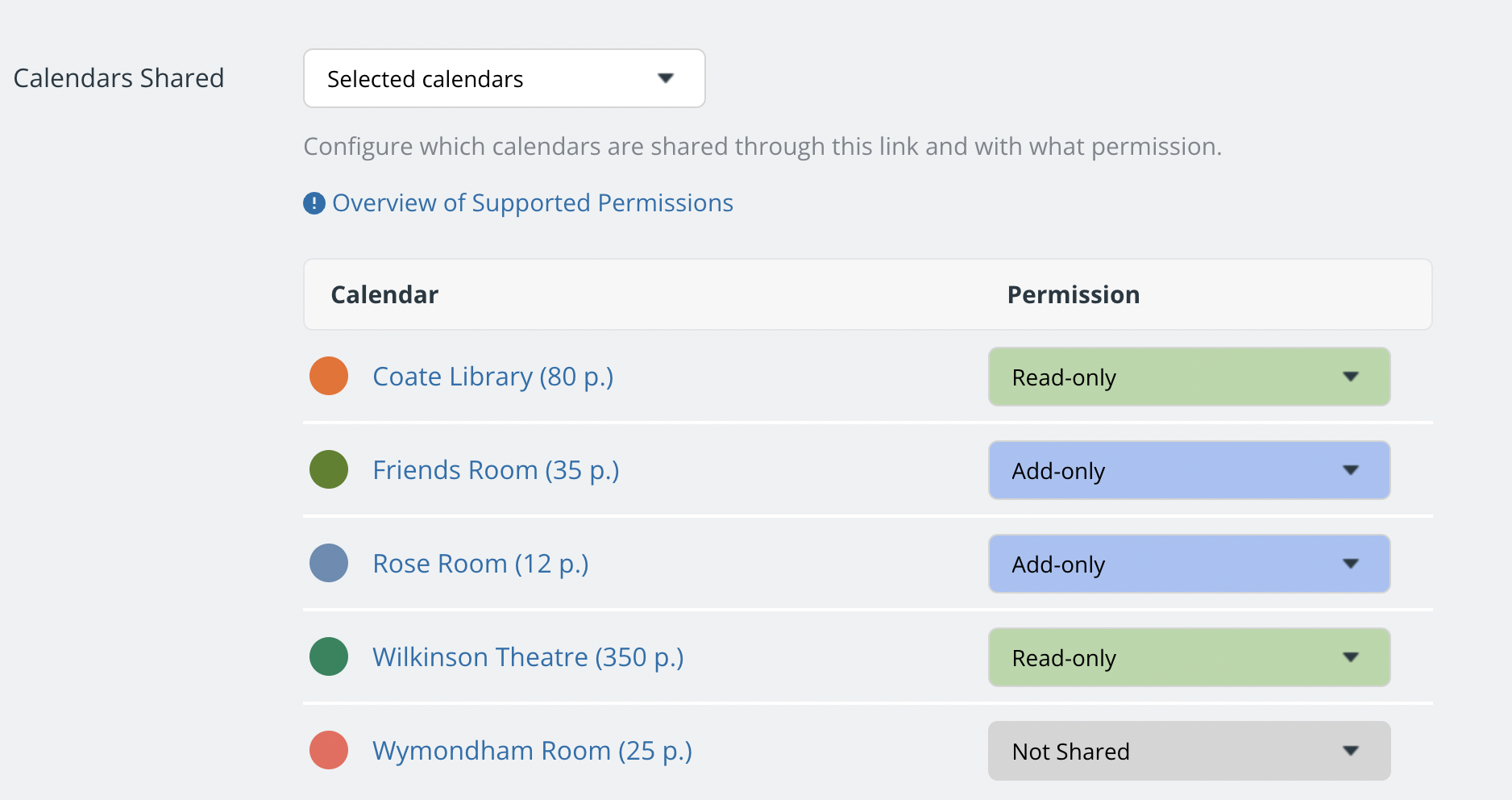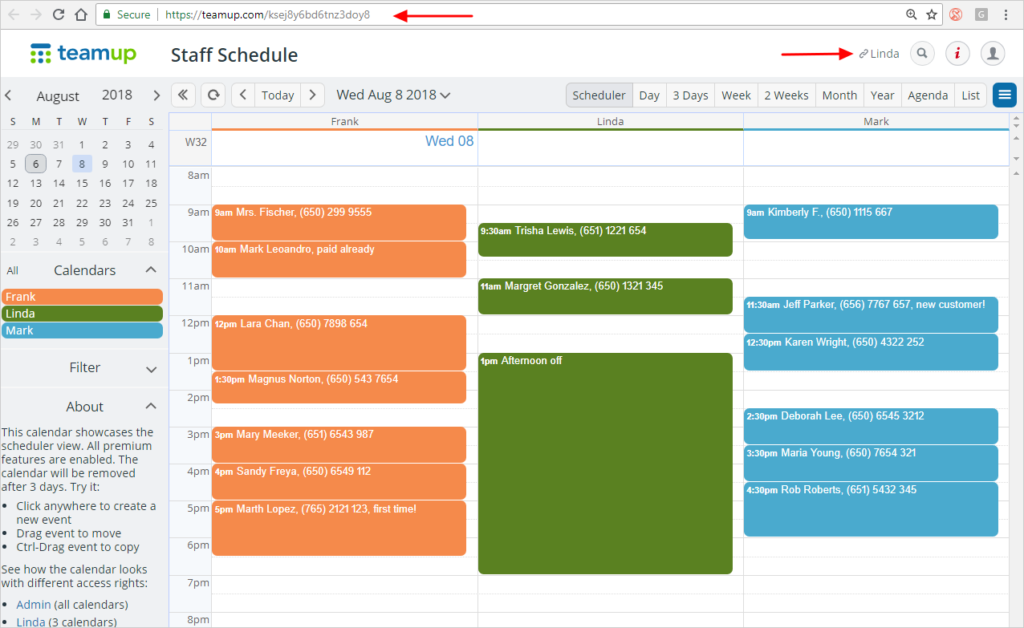A Teamup Calendar always has at least one sub-calendar and can have multiple sub-calendars. These can be set up by the calendar administrator in Settings > Calendars.
Giving users access to a Teamup calendar is what we call sharing. The calendar administrator can add and manage account users, or create unique shareable calendar links. This article discusses how to share selected sub-calendars, with customized access permission, via shareable links.
Create shareable calendar links
Here’s how to create a shareable link:
- Go to Settings > Sharing.
- Click Add link button on the right.
- Name the link clearly to indicate the purpose of the link.
- Continue as shown below to select sub-calendars and customize the access permission.
- Click on Save when finished.
See more details.
Name the link clearly
Here’s what we recommend:
- For an individual user, use that person’s name.
- For a user group or a category of events, name it with the group or category name.
- It can also be helpful to indicate the access level the link should have (e.g. read-only, modify, mixed, add-only).
This naming protocol helps to avoid confusion. Once you add the link to your dashboard, the link name is visible in addition to the calendar title; having the link clearly named makes it easy to remember who uses the link and what purpose it serves.
Select which sub-calendars to share
In the section Calendars Shared, choose Selected calendars from the drop-down menu. Then set the desired access permission for each sub-calendar. For any calendar you do not wish to include in the link, set the permission to Not Shared. Setting the calendar permission to Not Shared means that the sub-calendar will not be included in the link:

Set the access level for shared sub-calendars
- For each sub-calendar you wish to include in the link select the Permission to the access level that’s appropriate. In the example above, the shareable link include Read-only permission for two sub-calendars and Add-only permission for two other sub-calendars. See more details about each level of access permission below.
The calendar administrator can return to Settings > Sharing anytime to see a list of shareable calendar links and manage them as needed.
Send shareable links to others
Once a link is created, you will see the link listed in your Sharing screen. Simply copy the link to your clipboard:
This list on the Sharing screen includes not only links but also account-based users and groups. The shareable links are designated by a green link symbol. Use the filter above the list to see Links only or another type of access.
Please note that on the mobile app the user who is given the link access to the calendar can select ‘Continue without account’ on the bottom of the login screen. See the tutorials for iOS app and Android app for more details.
Flexible access permissions
Teamup currently supports the following access permissions:
- Administrator: Includes all permissions and is the only permission level allowing access to the calendar Settings. When you create a new calendar, you are provided with administrator access via your user account. Be very careful about granting administrator access to anyone else. Only grant administrator access to individuals authorized to access the calendar settings, and do so by assigning administrator permission via that individual’s user account.
- Modify: View, modify, create and delete calendar events.
- Read-only: View calendar events including details but can not make changes.
- Read-only, no details: View calendar with events marked as reserved time blocks but no further event details. No changes are allowed.
- Add-only: Allows adding new events, can only read but not modify any existing events. Newly added events can be modified only during the current browser session (up to approximately 30 minutes).
- Add-only, no details: Same as Add-only but the details of any existing events are hidden (marked as reserved).
- Modify-from-same-link: Add new events and modify any existing events that are created via the same link, but can only read and not modify any existing events created via other calendar links.
- Modify-from-same-link, no details: Add new events and modify any existing events that are created via the same link, but the details of any events created by others will be hidden (marked as reserved).
Assign shareable calendar links
A calendar link is equivalent to an “unlisted” private link of a YouTube video, i.e. only people who know the link to the calendar can access it. Administrators can assign one unique calendar link for an individual or a group and can deactivate, modify, or delete calendar links at any time.
Each calendar link is uniquely represented by:
- A unique and private URL. Each calendar link contains a long randomized strand of letters and numbers. This makes it invisible to search engines.
- The calendar view for each link always shows a list of shared sub-calendars for the specific user or user group; a small lock sign icon precedes all read-only calendars
- Each link can be named for the individual or group that will use it for their access.

Share calendars with account users
You can also share selected sub-calendars, with customized access permission, by adding account users. See this article for more.
As mentioned above, Teamup allows you to give account-based calendar access to Teamup registered account users. Account user access has several benefits:
- A higher level of security, since each user is linked to a verified email address and must log in to access the calendar(s).
- Ability to sync between browsers and mobile devices.
- A synced calendar dashboard.
- Ability to use event reminders.
Account users can also be added to groups, and you can provide calendar access to all members of a group. As the calendar administrator, you have control of the sub-calendars shared and the access permission set for each account user and for each group.
You can still create customized shareable links and provide calendar access via these links. With account-based users, organizations, team leaders, and others can enjoy added security and manage their employees and teams in a more efficient way.
To learn more about working with users and groups, see this article.
